Business Strategies and Analysis of Mattel's Toy Recall Incidents
VerifiedAdded on 2023/06/03
|5
|1230
|401
Report
AI Summary
This report analyzes Mattel's toy recalls, examining the reasons behind the recalls, including manufacturing defects like lead paint and design flaws involving magnets, and product misuse. It explores the advantages companies gain from overseas production, such as cheap labor and raw materials, while also highlighting the challenges. The report discusses Mattel's response to the recalls, evaluating the company's actions and the need for improved quality control and safety standards. It also considers the impact on China's manufacturing sector and suggests strategies for preventing future incidents, including enhanced quality licensing and inspection units. Furthermore, the report emphasizes the importance of building strong relationships with suppliers and better supply chain management to ensure product safety and accountability in overseas manufacturing.
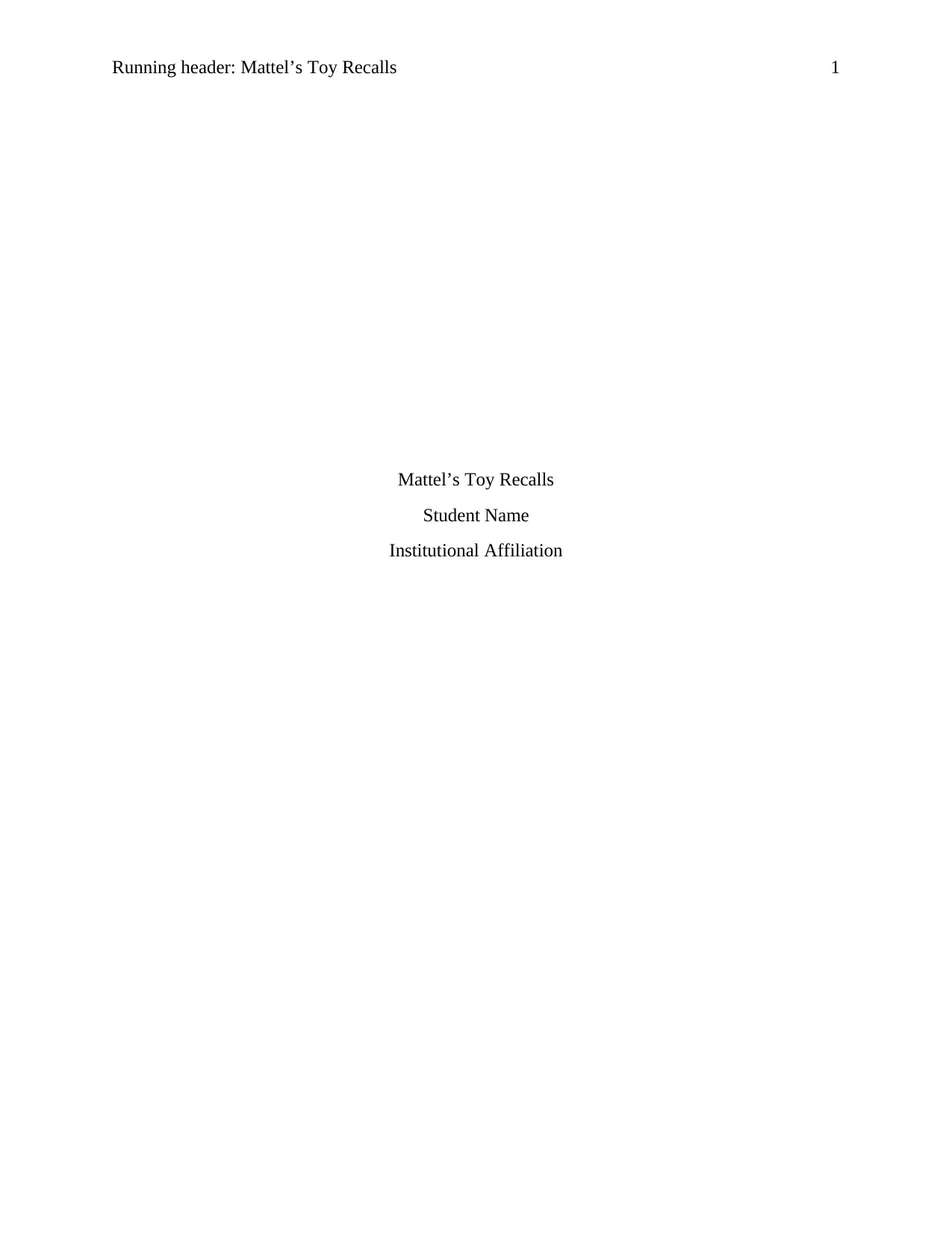
Running header: Mattel’s Toy Recalls 1
Mattel’s Toy Recalls
Student Name
Institutional Affiliation
Mattel’s Toy Recalls
Student Name
Institutional Affiliation
Paraphrase This Document
Need a fresh take? Get an instant paraphrase of this document with our AI Paraphraser
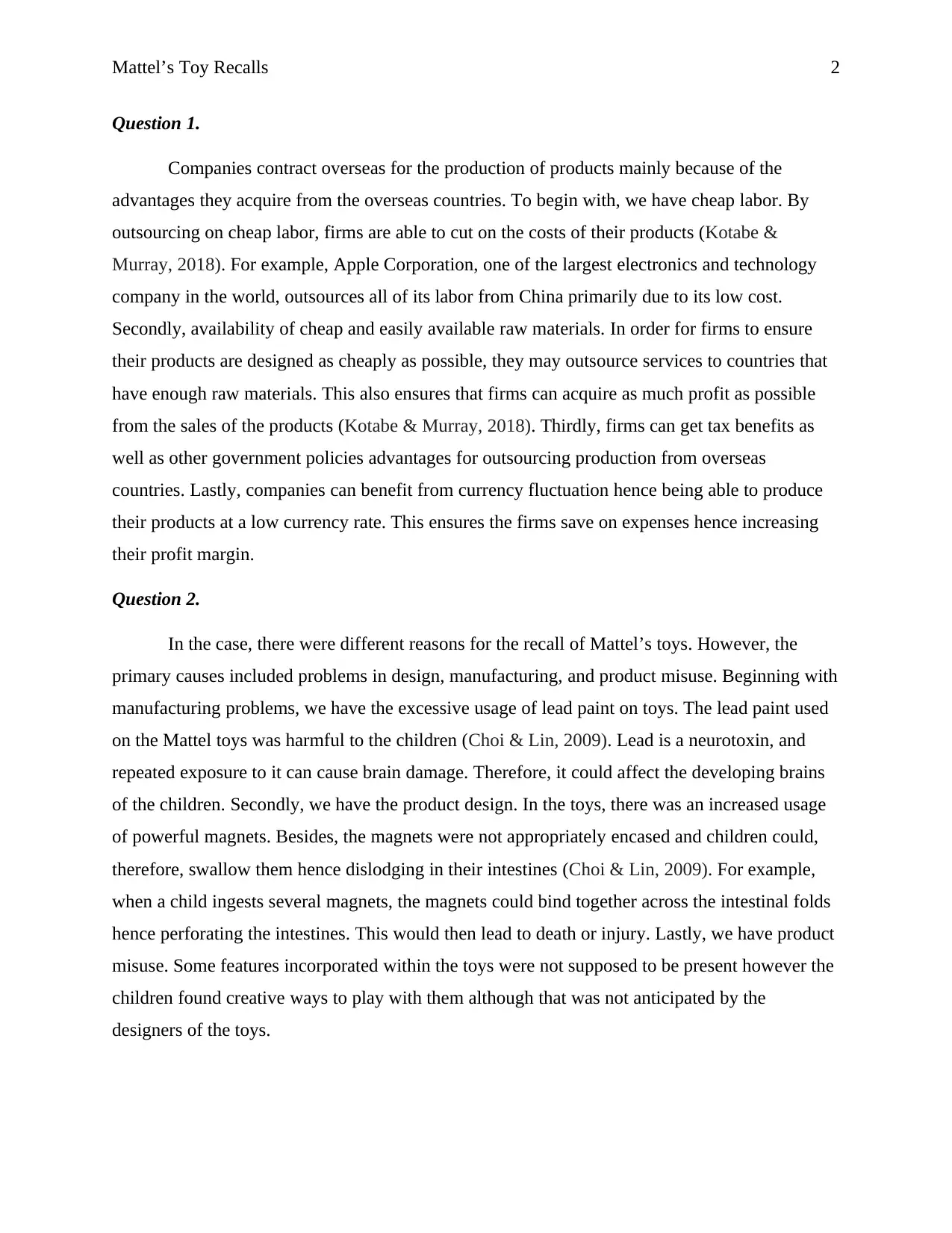
Mattel’s Toy Recalls 2
Question 1.
Companies contract overseas for the production of products mainly because of the
advantages they acquire from the overseas countries. To begin with, we have cheap labor. By
outsourcing on cheap labor, firms are able to cut on the costs of their products (Kotabe &
Murray, 2018). For example, Apple Corporation, one of the largest electronics and technology
company in the world, outsources all of its labor from China primarily due to its low cost.
Secondly, availability of cheap and easily available raw materials. In order for firms to ensure
their products are designed as cheaply as possible, they may outsource services to countries that
have enough raw materials. This also ensures that firms can acquire as much profit as possible
from the sales of the products (Kotabe & Murray, 2018). Thirdly, firms can get tax benefits as
well as other government policies advantages for outsourcing production from overseas
countries. Lastly, companies can benefit from currency fluctuation hence being able to produce
their products at a low currency rate. This ensures the firms save on expenses hence increasing
their profit margin.
Question 2.
In the case, there were different reasons for the recall of Mattel’s toys. However, the
primary causes included problems in design, manufacturing, and product misuse. Beginning with
manufacturing problems, we have the excessive usage of lead paint on toys. The lead paint used
on the Mattel toys was harmful to the children (Choi & Lin, 2009). Lead is a neurotoxin, and
repeated exposure to it can cause brain damage. Therefore, it could affect the developing brains
of the children. Secondly, we have the product design. In the toys, there was an increased usage
of powerful magnets. Besides, the magnets were not appropriately encased and children could,
therefore, swallow them hence dislodging in their intestines (Choi & Lin, 2009). For example,
when a child ingests several magnets, the magnets could bind together across the intestinal folds
hence perforating the intestines. This would then lead to death or injury. Lastly, we have product
misuse. Some features incorporated within the toys were not supposed to be present however the
children found creative ways to play with them although that was not anticipated by the
designers of the toys.
Question 1.
Companies contract overseas for the production of products mainly because of the
advantages they acquire from the overseas countries. To begin with, we have cheap labor. By
outsourcing on cheap labor, firms are able to cut on the costs of their products (Kotabe &
Murray, 2018). For example, Apple Corporation, one of the largest electronics and technology
company in the world, outsources all of its labor from China primarily due to its low cost.
Secondly, availability of cheap and easily available raw materials. In order for firms to ensure
their products are designed as cheaply as possible, they may outsource services to countries that
have enough raw materials. This also ensures that firms can acquire as much profit as possible
from the sales of the products (Kotabe & Murray, 2018). Thirdly, firms can get tax benefits as
well as other government policies advantages for outsourcing production from overseas
countries. Lastly, companies can benefit from currency fluctuation hence being able to produce
their products at a low currency rate. This ensures the firms save on expenses hence increasing
their profit margin.
Question 2.
In the case, there were different reasons for the recall of Mattel’s toys. However, the
primary causes included problems in design, manufacturing, and product misuse. Beginning with
manufacturing problems, we have the excessive usage of lead paint on toys. The lead paint used
on the Mattel toys was harmful to the children (Choi & Lin, 2009). Lead is a neurotoxin, and
repeated exposure to it can cause brain damage. Therefore, it could affect the developing brains
of the children. Secondly, we have the product design. In the toys, there was an increased usage
of powerful magnets. Besides, the magnets were not appropriately encased and children could,
therefore, swallow them hence dislodging in their intestines (Choi & Lin, 2009). For example,
when a child ingests several magnets, the magnets could bind together across the intestinal folds
hence perforating the intestines. This would then lead to death or injury. Lastly, we have product
misuse. Some features incorporated within the toys were not supposed to be present however the
children found creative ways to play with them although that was not anticipated by the
designers of the toys.
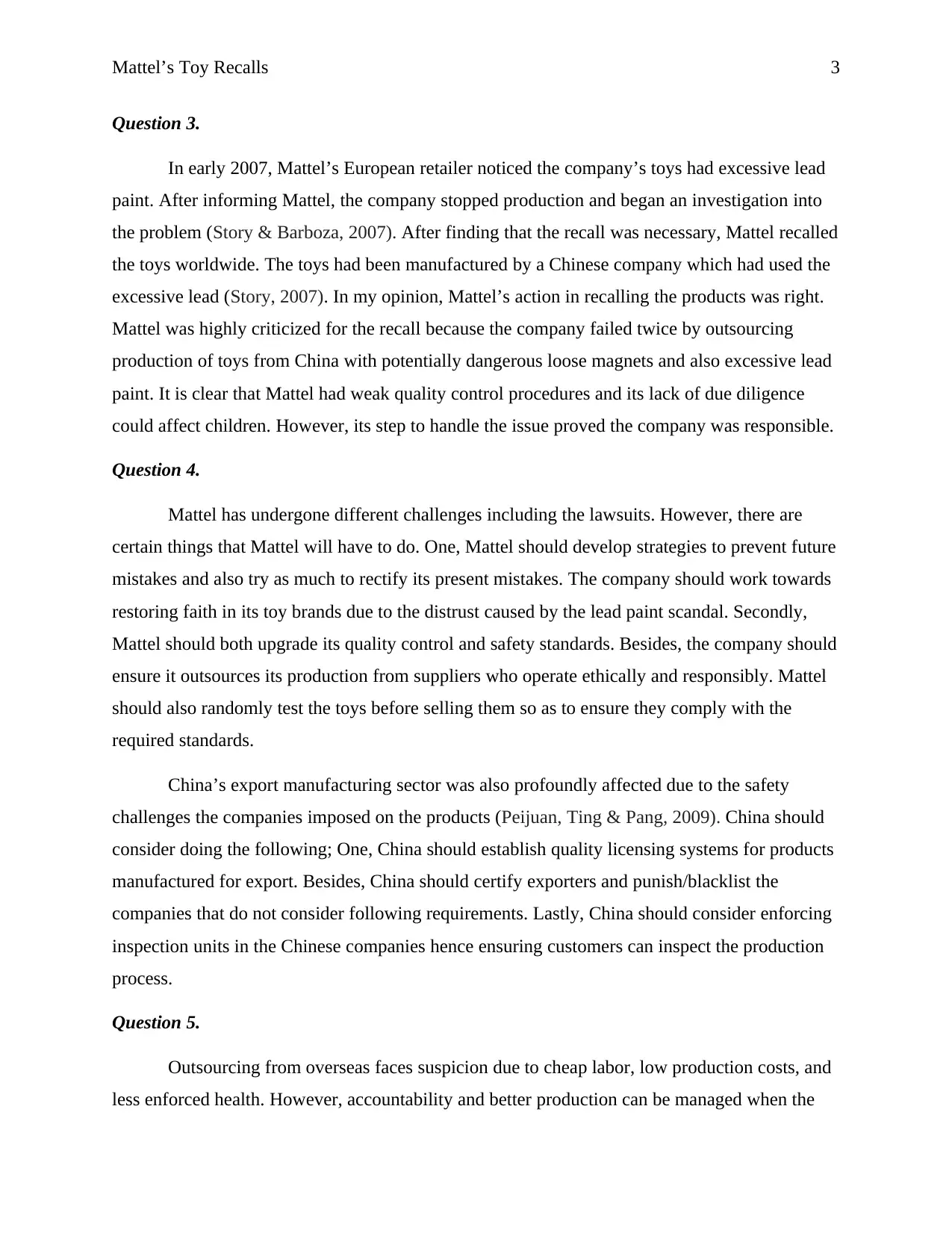
Mattel’s Toy Recalls 3
Question 3.
In early 2007, Mattel’s European retailer noticed the company’s toys had excessive lead
paint. After informing Mattel, the company stopped production and began an investigation into
the problem (Story & Barboza, 2007). After finding that the recall was necessary, Mattel recalled
the toys worldwide. The toys had been manufactured by a Chinese company which had used the
excessive lead (Story, 2007). In my opinion, Mattel’s action in recalling the products was right.
Mattel was highly criticized for the recall because the company failed twice by outsourcing
production of toys from China with potentially dangerous loose magnets and also excessive lead
paint. It is clear that Mattel had weak quality control procedures and its lack of due diligence
could affect children. However, its step to handle the issue proved the company was responsible.
Question 4.
Mattel has undergone different challenges including the lawsuits. However, there are
certain things that Mattel will have to do. One, Mattel should develop strategies to prevent future
mistakes and also try as much to rectify its present mistakes. The company should work towards
restoring faith in its toy brands due to the distrust caused by the lead paint scandal. Secondly,
Mattel should both upgrade its quality control and safety standards. Besides, the company should
ensure it outsources its production from suppliers who operate ethically and responsibly. Mattel
should also randomly test the toys before selling them so as to ensure they comply with the
required standards.
China’s export manufacturing sector was also profoundly affected due to the safety
challenges the companies imposed on the products (Peijuan, Ting & Pang, 2009). China should
consider doing the following; One, China should establish quality licensing systems for products
manufactured for export. Besides, China should certify exporters and punish/blacklist the
companies that do not consider following requirements. Lastly, China should consider enforcing
inspection units in the Chinese companies hence ensuring customers can inspect the production
process.
Question 5.
Outsourcing from overseas faces suspicion due to cheap labor, low production costs, and
less enforced health. However, accountability and better production can be managed when the
Question 3.
In early 2007, Mattel’s European retailer noticed the company’s toys had excessive lead
paint. After informing Mattel, the company stopped production and began an investigation into
the problem (Story & Barboza, 2007). After finding that the recall was necessary, Mattel recalled
the toys worldwide. The toys had been manufactured by a Chinese company which had used the
excessive lead (Story, 2007). In my opinion, Mattel’s action in recalling the products was right.
Mattel was highly criticized for the recall because the company failed twice by outsourcing
production of toys from China with potentially dangerous loose magnets and also excessive lead
paint. It is clear that Mattel had weak quality control procedures and its lack of due diligence
could affect children. However, its step to handle the issue proved the company was responsible.
Question 4.
Mattel has undergone different challenges including the lawsuits. However, there are
certain things that Mattel will have to do. One, Mattel should develop strategies to prevent future
mistakes and also try as much to rectify its present mistakes. The company should work towards
restoring faith in its toy brands due to the distrust caused by the lead paint scandal. Secondly,
Mattel should both upgrade its quality control and safety standards. Besides, the company should
ensure it outsources its production from suppliers who operate ethically and responsibly. Mattel
should also randomly test the toys before selling them so as to ensure they comply with the
required standards.
China’s export manufacturing sector was also profoundly affected due to the safety
challenges the companies imposed on the products (Peijuan, Ting & Pang, 2009). China should
consider doing the following; One, China should establish quality licensing systems for products
manufactured for export. Besides, China should certify exporters and punish/blacklist the
companies that do not consider following requirements. Lastly, China should consider enforcing
inspection units in the Chinese companies hence ensuring customers can inspect the production
process.
Question 5.
Outsourcing from overseas faces suspicion due to cheap labor, low production costs, and
less enforced health. However, accountability and better production can be managed when the
⊘ This is a preview!⊘
Do you want full access?
Subscribe today to unlock all pages.

Trusted by 1+ million students worldwide
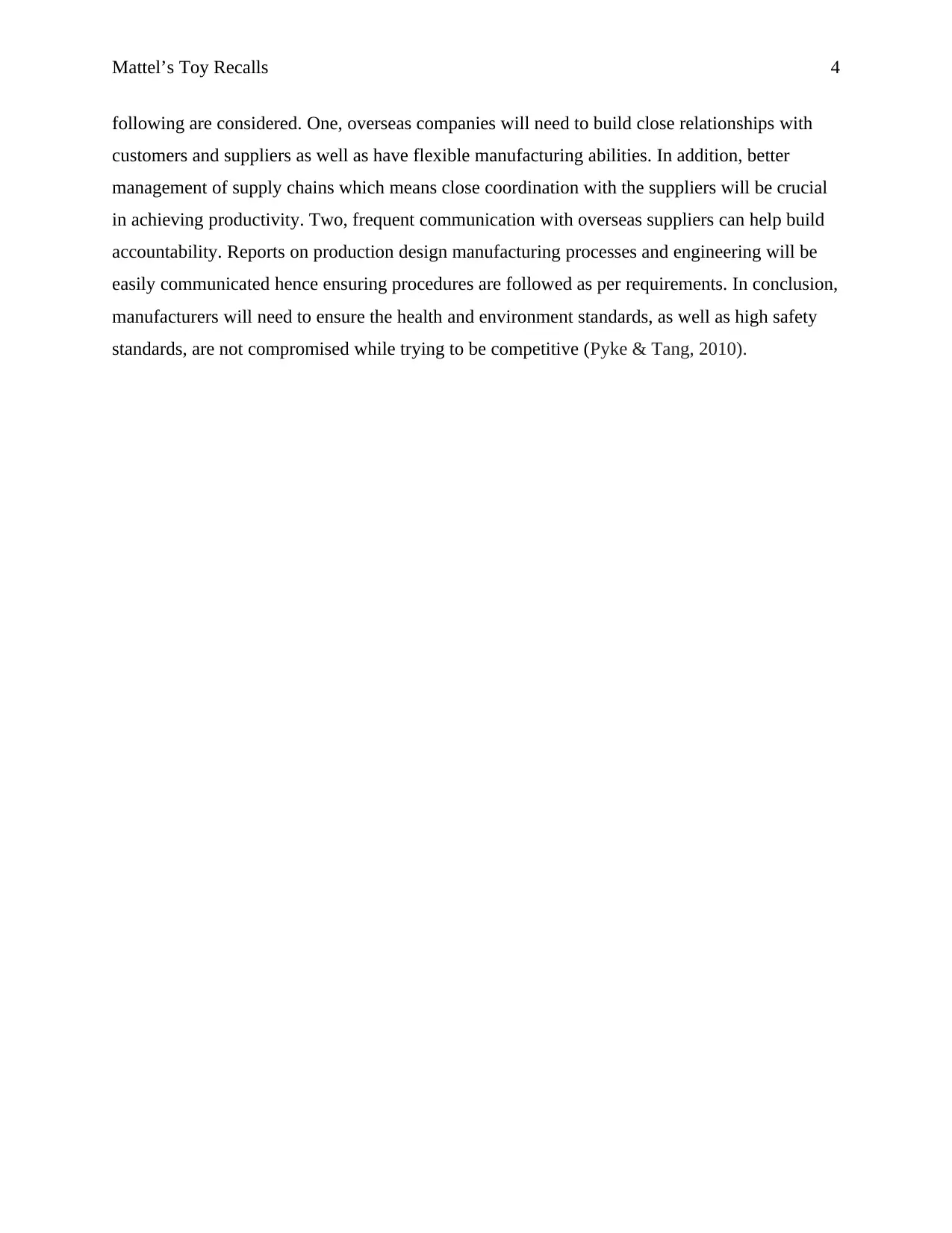
Mattel’s Toy Recalls 4
following are considered. One, overseas companies will need to build close relationships with
customers and suppliers as well as have flexible manufacturing abilities. In addition, better
management of supply chains which means close coordination with the suppliers will be crucial
in achieving productivity. Two, frequent communication with overseas suppliers can help build
accountability. Reports on production design manufacturing processes and engineering will be
easily communicated hence ensuring procedures are followed as per requirements. In conclusion,
manufacturers will need to ensure the health and environment standards, as well as high safety
standards, are not compromised while trying to be competitive (Pyke & Tang, 2010).
following are considered. One, overseas companies will need to build close relationships with
customers and suppliers as well as have flexible manufacturing abilities. In addition, better
management of supply chains which means close coordination with the suppliers will be crucial
in achieving productivity. Two, frequent communication with overseas suppliers can help build
accountability. Reports on production design manufacturing processes and engineering will be
easily communicated hence ensuring procedures are followed as per requirements. In conclusion,
manufacturers will need to ensure the health and environment standards, as well as high safety
standards, are not compromised while trying to be competitive (Pyke & Tang, 2010).
Paraphrase This Document
Need a fresh take? Get an instant paraphrase of this document with our AI Paraphraser
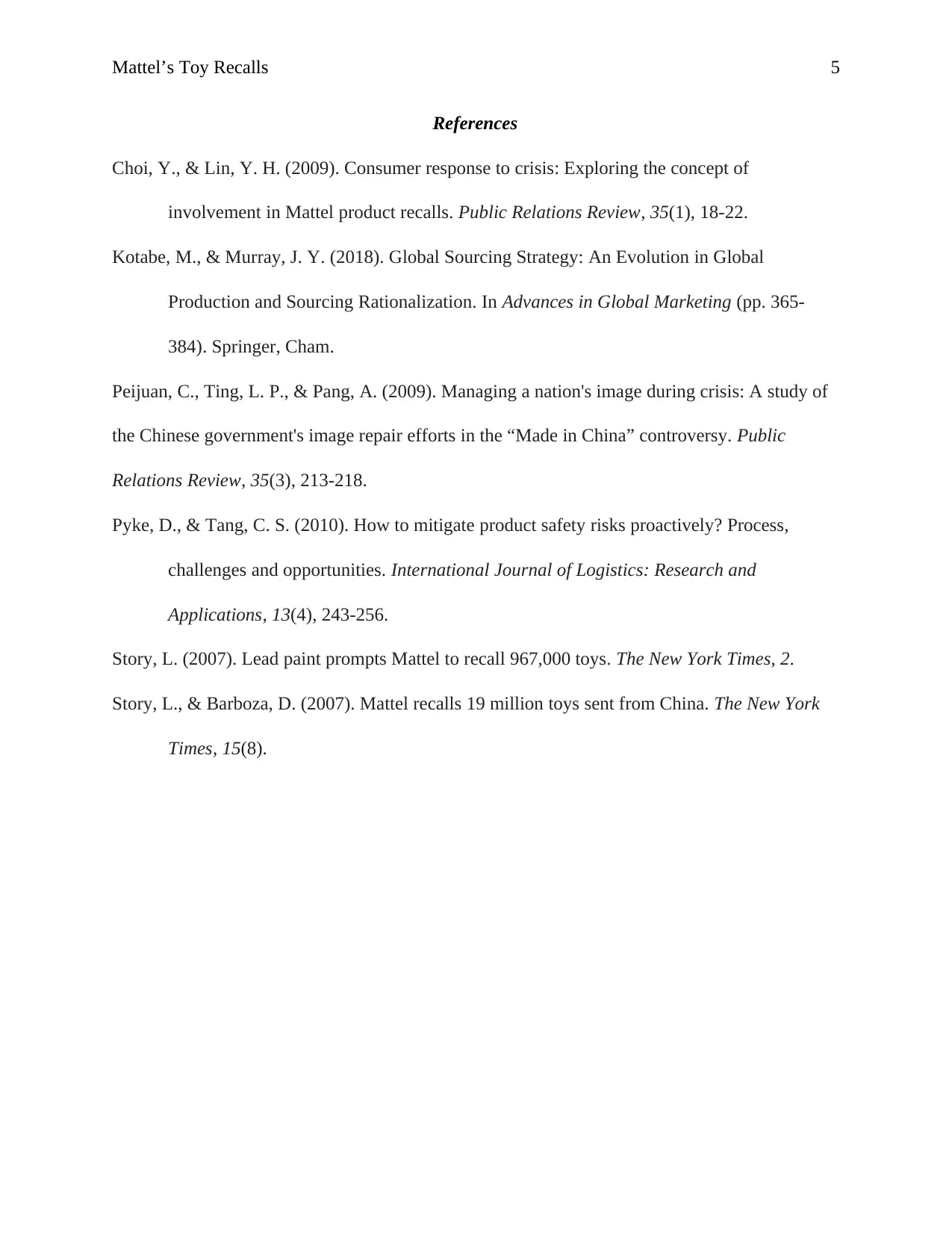
Mattel’s Toy Recalls 5
References
Choi, Y., & Lin, Y. H. (2009). Consumer response to crisis: Exploring the concept of
involvement in Mattel product recalls. Public Relations Review, 35(1), 18-22.
Kotabe, M., & Murray, J. Y. (2018). Global Sourcing Strategy: An Evolution in Global
Production and Sourcing Rationalization. In Advances in Global Marketing (pp. 365-
384). Springer, Cham.
Peijuan, C., Ting, L. P., & Pang, A. (2009). Managing a nation's image during crisis: A study of
the Chinese government's image repair efforts in the “Made in China” controversy. Public
Relations Review, 35(3), 213-218.
Pyke, D., & Tang, C. S. (2010). How to mitigate product safety risks proactively? Process,
challenges and opportunities. International Journal of Logistics: Research and
Applications, 13(4), 243-256.
Story, L. (2007). Lead paint prompts Mattel to recall 967,000 toys. The New York Times, 2.
Story, L., & Barboza, D. (2007). Mattel recalls 19 million toys sent from China. The New York
Times, 15(8).
References
Choi, Y., & Lin, Y. H. (2009). Consumer response to crisis: Exploring the concept of
involvement in Mattel product recalls. Public Relations Review, 35(1), 18-22.
Kotabe, M., & Murray, J. Y. (2018). Global Sourcing Strategy: An Evolution in Global
Production and Sourcing Rationalization. In Advances in Global Marketing (pp. 365-
384). Springer, Cham.
Peijuan, C., Ting, L. P., & Pang, A. (2009). Managing a nation's image during crisis: A study of
the Chinese government's image repair efforts in the “Made in China” controversy. Public
Relations Review, 35(3), 213-218.
Pyke, D., & Tang, C. S. (2010). How to mitigate product safety risks proactively? Process,
challenges and opportunities. International Journal of Logistics: Research and
Applications, 13(4), 243-256.
Story, L. (2007). Lead paint prompts Mattel to recall 967,000 toys. The New York Times, 2.
Story, L., & Barboza, D. (2007). Mattel recalls 19 million toys sent from China. The New York
Times, 15(8).
1 out of 5
Your All-in-One AI-Powered Toolkit for Academic Success.
+13062052269
info@desklib.com
Available 24*7 on WhatsApp / Email
![[object Object]](/_next/static/media/star-bottom.7253800d.svg)
Unlock your academic potential
Copyright © 2020–2025 A2Z Services. All Rights Reserved. Developed and managed by ZUCOL.